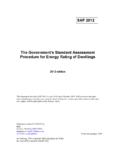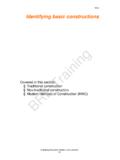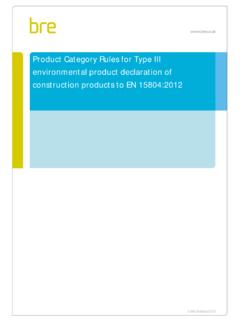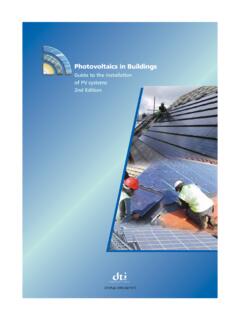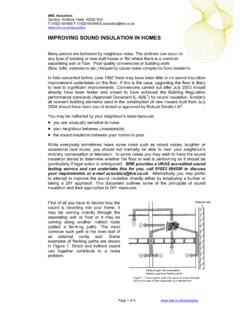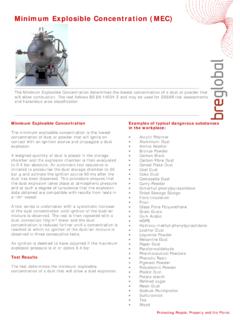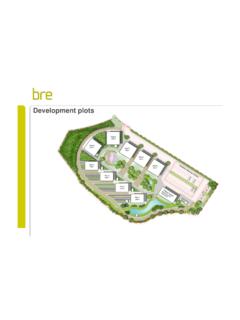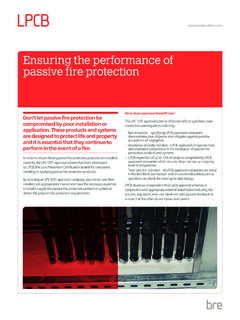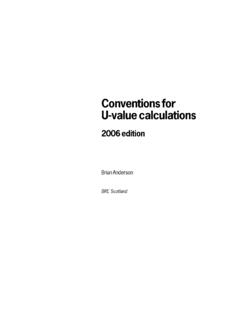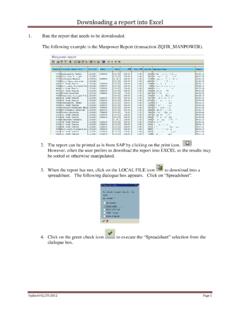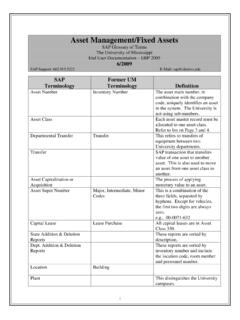Transcription of Appendix S: Reduced Data SAP for existing dwellings
1 RdSAP 2012 version (19 November 2017) 1 Appendix S: Reduced Data SAP for existing dwellings Reduced Data SAP (RdSAP) has been developed by government for use in existing dwellings based on a site survey of the property, when the complete data set for a SAP calculation is not available. It consists of a system of data collection (defined in Table S19) together with defaults and inference procedures, as defined by the rules given in this Appendix , that generate a complete set of input data for the SAP calculation. For any item not mentioned in this Appendix , the procedures and data given elsewhere in this document apply. The calculation starting from Reduced data is done in two stages. First the Reduced data set is expanded into a full data set (see S14 for rounding rules), and then the SAP calculation is undertaken using the expanded data set. The actual SAP calculation is therefore identical, whether starting from a Reduced data set or a full data set.
2 This Appendix forms part of SAP 2012 and provides a methodology for existing dwellings that is compliant with the Energy Performance of Buildings Directive. It is not appropriate for new dwellings for which all data for the SAP calculation should be acquired related to the dwelling concerned. This Appendix contains the data and rules for expanding the data collected in a Reduced Data survey into the data required for the SAP calculation. Information in shaded boxes is primarily concerned with data collection and is addressed to energy assessors. Table S19 lists the Reduced Data set. S1 Dwelling types dwellings are classified as one of house bungalow flat maisonette park home and one of detached semi-detached mid-terrace end-terrace enclosed mid-terrace enclosed end-terrace Reduced Data SAP is for existing dwellings only. Any new dwelling, including (except in Scotland) dwellings created by change of use, must be assessed using SAP.
3 A house or bungalow has a complete heat loss ground floor and a completely exposed roof. A dwelling without a heat loss floor cannot be a house and must be treated as a flat or maisonette. A flat or maisonette does not have both a heat loss ground floor and a heat loss roof. RdSAP makes no distinction between a flat and a maisonette as regards calculations; it is acceptable to select either type as definitions vary across the UK. Enclosed is typically applicable for back-to-back terraces and has the following meaning: mid-terrace has external walls on two opposite sides; enclosed mid terrace has an external wall on one side only; end-terrace has three external walls; enclosed end-terrace has two adjacent external walls. Many dwellings have one or more extensions either added onto the main part, or built at the same time but of different construction or insulation. In these cases, dimensions and constructional details of the main part of the dwelling and each extension are recorded separately, to allow the assignment of different U-values to the original and to the extension.
4 In addition, dwellings can have a different construction for some parts of the walls (for example, a timber framed bay window in otherwise masonry construction). These are recorded as a separate constructional element, termed alternative wall . If the area of an alternative wall is less than 10% of the total wall area it can be disregarded. RdSAP 2012 version (19 November 2017) 2 Park homes The Energy Performance of Buildings regulations do not require an EPC for a park home. However, data are provided to enable the assessment of a park home. Data for park homes The following data items apply to a park home. Data items for park homes Data item Options Built form Detached only Measurements Internal or external Number of storeys 1 only Number extension Up to 4. Extensions must have park home attributes (wall, floor and roof types) Habitable rooms Up to 99 Roof type and insulation Pitched access Pitched no access Insulation at joists use Table S9 if measured or documentary evidence of insulation thickness; otherwise Table S10 Insulation at rafters use Table S10 (park home column) Unknown use Table S10 park home column As built use Table S10 park home column None Pitched sloping ceiling Flat As built use Table S10 park home column o Unknown use Table S10 park home column Roof rooms Disallowed Walls Park home wall only Party walls None no party wall Wall thickness Measured or default from Table S3 Dry lining Disallowed Wall insulation As-built Unknown Internal (U-value entry only) External (U-value entry only) Alternative walls No alternative wall Floor Ground Suspended timber only U-value entry possible.
5 Floor insulation As built Unknown Retro- fitted (U-value entry only) Glazing Always much more than typical and measure all windows Heating and hot water All options as normal Conservatory Possible (one storey) Open fireplaces Always none Ventilation Always natural Insulation improvements for park homes For the assessment of improvement measures for park homes the improved U-value of its wall, floor or roof is calculated using: insexistinginsulatedRU11U RdSAP 2012 version (19 November 2017) 3 where Uinsulated is the improved U-value, Uexisting is the U-value of the existing element and Rins is the thermal resistance added. S2 Age bands A set of age bands is defined according to Table S1 for the purposes of assigning U-values and other data. Table S1 : Age bands Years of construction Age band England & Wales Scotland Northern Ireland Park home (UK) A before 1900 before 1919 before 1919 - B 1900-1929 1919-1929 1919-1929 - C 1930-1949 1930-1949 1930-1949 - D 1950-1966 1950-1964 1950-1973 - E 1967-1975 1965-1975 1974-1977 - F 1976-1982 1976-1983 1978-1985 before 1983 G 1983-1990 1984-1991 1986-1991 1983-1995 H 1991-1995 1992-1998 1992-1999 (not applicable) I 1996-2002 1999-2002 2000-2006 1996-2005 J 2003-2006 2003-2007 (not applicable) (not applicable) K 2007-2011 2008-2011 2007-2013 2006 onwards L 2012 onwards 2012 onwards 2014 onwards (not applicable) S3 Areas Areas are determined separately for the main part of the dwelling and any extension.
6 Horizontal dimensions can be measured either internally or externally. From the 1960s, constructional changes have been caused primarily by amendments to building regulations for the conservation of fuel and power, which have called for increasing levels of thermal insulation. The dates in Table S1 are generally one year after a change in regulations, to allow for completion of dwellings approved under the previous regulations. For a conversion which was a change of use ( barn converted to dwelling) or where a dwelling has been sub-divided ( house to flats) use the original construction date, unless there is documentary evidence that all thermal elements have been upgraded to the building regulation standards applicable at the conversion date. Enter insulation levels only for those elements for which evidence is available. Age band L can apply to extensions added to an older property. RdSAP 2012 version (19 November 2017) 4 The measurements required are the floor area, exposed perimeter, party wall length and room height on each storey.
7 Exposed perimeter includes the wall between the dwelling and an unheated garage or a separated conservatory and, in the case of a flat or maisonette, the wall between the dwelling and an unheated corridor. Internal dimensions are permissible in all cases. In the case of a house or bungalow external dimensions for area and perimeter are usually more convenient, except where access to all sides of the building is not possible or where there are differing wall thicknesses or other aspects that would make the dimensional conversion unreliable. When using external measurements for a dwelling joined onto another dwelling (semi-detached and terraced houses) the measurement is to the mid-point of the party wall. Flats and maisonettes are usually measured internally (although it is not a requirement of the specification that internal measurements are always used and if measured externally the measurement is to the mid-point of the party wall). Whichever is chosen the same basis must be used for all parts of the dwelling.
8 Party wall length uses the same basis as exposed perimeter. Room heights are always measured internally within the room. State on site plans whether the dimensions recorded are external or internal. Where a combination of external and internal is used this must be made clear for each dimension indicated. When measuring internally, measure between the finished internal surfaces of the walls bounding the dwelling. Where that cannot be done directly ( when measuring room by room) include an allowance for the thickness of internal partitions. Measure all perturbations ( bay windows) but disregard chimney breasts unless assessor considers significant large inglenook. Vertical dimensions (room heights) are always measured internally within the room. Also, the floor area of room(s)-in-roof are always measured internally (irrespective of the dimensions basis for other storeys). Measure lengths to one decimal place ( m) or better. Retain higher precision when that has been measured (especially room heights).
9 If there is an alternative wall, it is identified as being part of the external wall of main dwelling or of one of the extensions. When calculating the area of alternative wall exclude the area of any windows and doors contained within it. Include the length of party wall between the dwelling being assessed and another heated space which can be: - another dwelling - commercial premises - a heated corridor or stairwell in a block of flats - a heated common area RdSAP 2012 version (19 November 2017) 5 Definition of the extent of the dwelling Generally rooms and other spaces, such as built-in cupboards, are included as part of the dwelling where these are directly accessible from the occupied area of the dwelling, whereas unheated spaces clearly divided from the dwelling are not. Basements Include in the assessment when accessed via a permanent fixed staircase such that one is able to walk downwards facing forwards and either:- - basement is heated via fixed heat emitters, or - basement is open to the rest of the dwelling, no door.
10 A basement does not necessarily contain habitable rooms. Do not mix internal and external measurements. If a basement is included in the assessment, it is likely that internal dimensions will be used throughout the dwelling. Attics and roof rooms Include in the assessment when accessed via a permanent fixed staircase such that one is able to walk downwards facing forwards. Does not necessarily contain habitable rooms. For a roof room to be classed as such and not a separate storey, the height of the common wall must be less than m for at least 50% of the common wall (excluding gable ends or party walls). The common wall is a vertical continuation of the external wall of the storey below. There is no explicit allowance for dormer windows except to include in the floor area of the roof rooms. See Figures S1 and S2 (next page). Rooms within a Mansard roof A storey having non-vertical walls of at least 70 pitch constitutes a separate storey; it is not treated as roof rooms.
